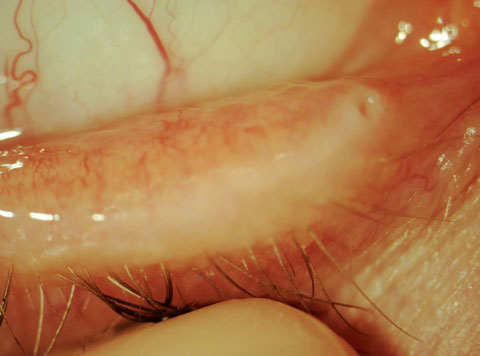 |
| Dysbiosis more commonly presents on the ocular surface microbiota of allergic conjunctivitis patients. Photo: Charissa Young, OD. Click image to enlarge. |
Allergic conjunctivitis reportedly causes alterations in the microbiota of the ocular surface. With this in mind, researchers recently investigated ocular surface microbiota dysbiosis in this cohort of patients, including those with vernal keratoconjunctivitis (VKC) and atopic keratoconjunctivitis (AKC) treated with topical tacrolimus.
Based on clinical scores and expression of specific cytokines such as of Il-8, CCL24 and IL-23A on the ocular surface, allergic conjunctivitis patients were divided into mild and severe groups using cluster analysis. The microbial composition of tear specimens collected from patients with mild and severe cases and control subjects using Schirmer testing was determined through next-generation 16S rRNA sequencing analysis.
The study found biodiversity levels in the both mild and severe groups “were significantly decreased, compared with those of the control group,” the authors concluded. “These alterations indicate a decrease in the number of bacterial species or an increase in the relative abundance of certain species of bacteria present in the ocular surface and may represent major characteristics of ocular surface microbiota in patients with VKC and AKC after tacrolimus ophthalmic treatment.”
The authors noted that it’s unclear whether these alterations are primarily due to allergic inflammation in the conjunctiva or tacrolimus.
“Because tacrolimus is reported to have no antibacterial effect, it is unlikely to affect the microbiota through antibacterial action,” the authors explained. “Therefore, alterations of the microbiota in the ocular surface of patients with [allergic conjunctivitis] are likely to be influenced by the atopic constitution of the host and allergic inflammation in the ocular surface.” These results “suggest that alterations in the relative abundance of taxa in the ocular surface microbiota are influenced by the atopic predisposition of the eye and partly by the severity of the” presentation, the authors reported.
When the ocular surface microbiota was compared between the mild and severe groups, an increased abundance of Blautia spp. was associated with severity of allergic conjunctivitis.
To better understand the pathogenesis of allergic inflammation in the ocular surface, “it is necessary to take into account the abundance of Blautia spp. in the ocular surface microbiota,” the authors suggested. “Furthermore, it is necessary to examine whether the abundance of Blautia spp. in the ocular surface is meaningful as a biomarker.”
Inada N, Shoji J, Harata G, et al. Dysbiosis of ocular surface microbiota in patients with refractive allergic conjunctival diseases. Cornea. 2021;00:1-10. |

